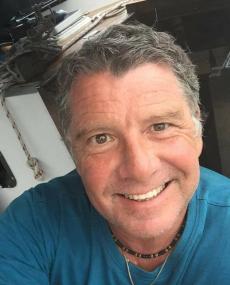
Dave Hartman was born in 1961 in Port Elizabeth, Eastern Province (now Eastern Cape) where he grew up in an English speaking liberal home. His mother was born in England and came to South Africa after the Second World War and married and settled down in Grahamstown where she was an active member of the Black Sash (a white woman’s organisation).
Hartman attended St Andrews College in Grahamstown for his secondary schooling. He was deeply emotionally affected by the 1976 Soweto students uprising and as a result he became active in student politics while at high school. After completing his Matric (Grade 12) year in 1978, Hartman enrolled at Rhodes University in Grahamstown, where he studied fine art and photography. In 1983, after completing his Honours degree Hartman spent a year travelling around South Africa on his bicycle and taking photographs which he later exhibited at the annual Grahamstown Arts Festival.
In his own opinion this trip deepened his understanding of the conditions in which black people in South Africa lived under apartheid, and his conviction that he should use his photographs to expose the evils of the system. As Hartman put it, “As a student and the UDF protest took off in 1985, I just knew that was where I was meant to be...I believed that I had a role in explaining what was happening.” (Interview with Hartman, 2009). He came to feel that documentary photography provided him “a legitimate way to use my skills to help educate my society starting with my own family.” (Interview with Hartman, 2009). Hartman maintains that as an arts student he was always concerned with personal expression. However he became increasingly disillusioned by this world which “seemed to offer very little to changing society. Social documentary photography offered an alternative. And definitely offered me a role to play in promoting change in South Africa.” (Interview with Hartman, 2009)
Hartman went on to do a Masters in Fine Arts which he did not complete as he became actively involved in the anti- conscription campaign and the formation of the End Conscription Campaign (ECC). He attended the ECC founding Conference in Cape Town in 1983, and established and ran the ECC office in Grahamstown.
On the completion of his studies in 1984, Hartman moved to Cape Town where he worked as an assistant to fashion photographer, Mike Donnelly. However as the political environment continued to heat up in the 1980’s Hartman says that he was increasingly frustrated, left his job in the fashion world and turned to photo-journalism and began covering political events. He taught photography at Capic, a community centre project in Cape Town. Hartman then started working as a photojournalist for Agence France Press where he would work for 3 years until 1987. Also during 1984, Hartman joined the photographic collective, Afrapix, of which he was a member until 1988 emigrated to Canada. Along with Chris Ledochowski and Paul Grendon, Hartman formed part of the Cape TownAfrapix branch.
In 1987, Hartman was charged for refusing to undergo compulsory military training and left the country for London, where he worked in the photographic unit of the banned International Defence and Aid Fund for Southern Africa(IDAF).
Hartman was one of 20 South African photographers whose work was represented in the 1989 Afrapix publication Beyond the Barricades: Popular Resistance in South Africa in the 1980s.
Hartman later moved to Canada where he continued to work as a freelance news and editorial photographer but also did social documentary essays on the working conditions of people in Northern America. In 1998 Hartman moved into new media after a 16 year career as an international photojournalist where he combined his photographic skills with the new IT technology to enable different forms of interactive storytelling. He argues that it is not the medium that is most important, but rather the story.
Works featured in publications:
Beyond the Barricades: Popular Resistance in South Africa in the 1980s, Aperture, 1989
Works featured in exhibitions:
Crossroads, The Market Photo Gallery Johannesburg, 1987